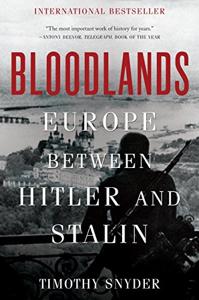
Want to learn the ideas in Bloodlands better than ever? Read the world’s #1 book summary of Bloodlands by Timothy Snyder here.
Read a brief 1-Page Summary or watch video summaries curated by our expert team. Note: this book guide is not affiliated with or endorsed by the publisher or author, and we always encourage you to purchase and read the full book.
Video Summaries of Bloodlands
We’ve scoured the Internet for the very best videos on Bloodlands, from high-quality videos summaries to interviews or commentary by Timothy Snyder.
1-Page Summary of Bloodlands
Overview
The Sleepwalkers by Christopher Clark takes a fresh look at the outbreak of World War I, focusing on the alliances that were established among Europe’s nations in the years leading up to 1914. In his compelling and masterful account, Clark examines how decisions made in those years led to war.
Nazi Germany committed horrible atrocities during World War II. It’s well-known that they killed millions of people in Europe. There have been many memorials and books written about those events, as a way to remember the victims of the war.
What’s often overlooked, however, is that Stalin also did a lot of bad things to his own people and other countries.
In modern day Poland, Ukraine, Belarus and the Baltic states, Russia’s Stalin and Germany’s Hitler waged war over these “bloodlands” for ideological dominance.
In this passage, you’ll learn about the key points of dictators and their regimes. You’ll discover how Stalin starved his people, while Hitler killed millions through war. Finally, you will see that Poland was completely different before the war than after it.
Big Idea #1: During the Stalin era, millions of people starved to death as a result of his forced farm collectivization.
In 1933, the West was suffering from the Great Depression. For some people in Eastern Europe, however, life was worse because of a famine caused by government policies.
In 1928, Joseph Stalin started a five-year plan to industrialize the Soviet Union. Part of this plan was collectivization of farms.
The government forced farmers to move from their small farms into bigger ones, where they would work the land together. Many farmers refused this policy and were given laws that gave collective farms legal advantages over smaller, private farms.
The government took away the right of farmers to vote for their own seed grain. This made it impossible for them to stay independent and survive, so they were forced to join collective farms instead.
The Communist Party in the Soviet Union made an effort to take over, or collectivize, farms and factories. Their goal was to make them more efficient. However when farmers had less control over their farms they weren’t as motivated to work hard because of poor incentives. What’s more, machinery at many collective farms were outdated and needed maintenance; winter also impacted production that year since there was a drought in some areas and heavy snowfall elsewhere. Farmers didn’t reach quotas so starvation became an issue.
Stalin was determined to meet his goals, even though collectivization had already failed. He demanded that farmers who missed their quotas hand over their grain and livestock to the government.
Farmers were forced to give up their seed grain for the following season, which meant they wouldn’t have enough food for themselves. The situation became dire in Ukraine and other places in Russia.
The Soviet Union experienced a famine in 1933 that killed an estimated 5.5 million people, with 3.3 million of those deaths occurring in Ukraine alone.
Big Idea #2: Stalin was a ruthless dictator who persecuted minorities and those he deemed to be enemies of the state.
The forced collectivization and economic plans that Stalin implemented were very harsh on the people of Russia, but they also helped spur rapid economic growth.
Despite the fact that many people were living in poverty, Stalin was afraid of them revolting against his policies. So he decided to take measures against anyone who might be a threat to him or the government.
Kulaks, wealthy farmers who were not happy about collectivization, became the focus of state persecution in 1929 and 1930. Kulaks were labeled as enemies of the Soviet Union and deported to remote areas. As kulak was an official term, officials could apply it to anyone they wanted. The government executed 380,000 people during dekulakization. Another group that Stalin feared was ethnic minorities living inside the Soviet Union. Stalin believed this minority could be used as a tool by other countries for invasion from the west; therefore he decided to blame them for causing problems in his country.





